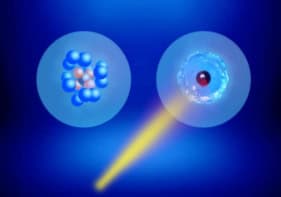
A battery-like device that supplies a current of ultracold atoms has been created by physicists at the University of Colorado in Boulder. Their “atomtronic” battery is based on a Bose–Einstein condensate (BEC) and could be used to supply circuits made from transistors and other components that operate using atomic rather than electronic currents. Potential applications of the battery include inertial sensing and quantum-information processing.
Atomtronics is a new field of applied physics that aims to create analogue and logical circuits using currents of atoms. According to Boulder’s Dana Anderson, “practical devices do not yet exist”, and his team is focused on developing an atom transistor and simple transistor circuits. In 2016 Anderson and colleagues reported the development of an atomtronic transistor based on a magneto-optical trap that contains three potential energy wells.
Now, Anderson, Seth Caliga and Cameron Straatsma have created an atomtronic battery that, in principle, could drive their transistor and other components. It consists of a gas of rubidium-87 trapped by magnetic fields in a long, thin cigar-shaped region. The BEC is created by cooling the atoms to an extremely low temperature so the atoms fall into the same low-energy quantum state. A repulsive energy barrier made from laser light is then swept across the trap from the right side to the centre, which pushes all of the atoms into the left half of the trap, leaving the right half empty (see figure). The energy barrier is then lowered in height to let atoms flow from the left half of the trap to the right half.
Chemical potential
Unlike conventional batteries, which are driven by an electrical potential, the atomtronic battery is driven by a chemical potential – which is related to the abundances of atoms in the left and right portions of the trap. “The atoms in the BEC repel each other,” explains Anderson. “They like to move away from each other, and given a circuit they can do so by causing a current of atoms.”
Anderson says that one possible use of the atomtronic battery is a temporally coherent source of matter waves – atoms that behave both as matter and waves. Such a source, he believes, could be combined with a matter-wave resonator to create an inertial sensor that could measure tiny accelerations. “Such circuitry would enable sensors that are competitive with current atom interferometers but be considerably smaller,” he says. The battery could also be used to apply quantum techniques to a problem known as “blind signal separation”, which aims to separate mixed signals from a number of different sources.
Anderson is also keen to demonstrate the quantum behaviour of his team’s atomtronic transistor. “This requires atomic temperatures that are in the range of 50 nK or so”. While colder temperatures have been achieved in laboratories, Anderson says such a demonstration involves significant technical challenges.
The atomtronic battery is described in New Journal of Physics.



